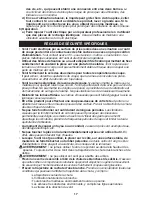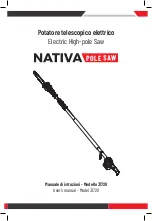
• Do not touch the workpiece or the blade immediately after operating the tool. They
can become very hot.
• When not in use, place tool on its side on a stable surface where it will not cause
a tripping or falling hazard. Some tools with large battery packs will stand upright but
may be easily knocked over.
WARNING:
Never use the tool above shoulder height. Always position yourself
out of the path of falling branches and debris.
WARNING:
Do not use this tool to fell trees.
• Pre-plan a safe exit from falling branches and debris. Ensure the exit route is clear
of obstacles that would prevent or hinder movement. Remember wet grass and freshly
cut bark is slippery.
• Be aware of the direction that a branch may fall. Consider all conditions that may
affect the direction of fall, including:
• The intended direction of fall.
• The natural lean of the branch.
• Any unusual heavy limb structure or decay.
• Surrounding trees and obstacles including overhead lines.
• The wind speed and direction.
• The safe distance between a branch and debris to be felled and bystanders,
buildings and other objects is at least 2 1/2 times the length of the branch. Any
bystander, building or object within this distance is at risk from being struck by the
falling branch.
• When cutting a limb that is under tension be aware of spring back. When the
tension in the wood fibers are released the spring loaded limb may strike the
operator and/or throw the tool out of control.
• Ensure someone is nearby (at a safe distance) in case of an accident.
• Do not attempt to operate the tool when in a tree, on a ladder or standing on
any other unstable support.
• keep proper footing and balance at all times.
• keep handles dry, clean and free from oil and grease. Greasy oily handles
are slippery causing loss of control.
• If any debris gets caught with the guard or tool discontinue use, disconnect
battery and clear debris. Keep away from jammed blade as it could move and present a
cutting hazard after it is freed.
WARNING:
Some dust created by this product contains chemicals known to the
State of California to cause cancer, birth defects or other reproductive harm. Some
examples of these chemicals are:
• compounds in fertilizers
• compounds in insecticides, herbicides and pesticides
• arsenic and chromium from chemically treated lumber
To reduce your exposure to these chemicals, wear approved safety equipment such
as dust masks that are specially designed to filter out microscopic particles.
WARNING:
ALWAYS use safety glasses. Everyday eyeglasses are NOT safety
glasses. Also use face or dust mask if cutting operation is dusty. ALWAYS WEAR
CERTIFIED SAFETY EQUIPMENT:
• ANSI Z87.1 eye protection (CAN/CSA Z94.3),
• ANSI S12.6 (S3.19) hearing protection,
• NIOSH/OSHA/MSHA respiratory protection.
WARNING:
Always wear proper personal hearing protection that conforms
to ANSI S12.6 (S3.19) during use. Under some conditions and duration of use,
noise from this product may contribute to hearing loss.
IMPORTANT SAFETY WARNINGS AND INSTRUCTIONS
TO REDUCE RISk OF INJURY:
• Before any use, be sure everyone using this tool reads and understands all safety
instructions and other information contained in this manual.
• Save these instructions and review frequently prior to use and in instructing others.
4





































